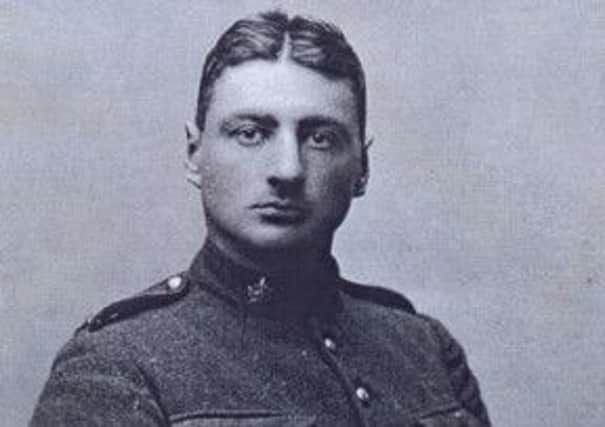Local historian’s research into men who paid the ultimate sacrifice


In the run up to the 100th anniversary of the First World War on Monday, here are the stories behind a couple of the men whose names feature on the war memorial.
Clitheroe resident Shirley painstakingly researched details of the men with many of the stories a poignant reminder of how local men contributed and lost their lives in the war to end all wars.
Advertisement
Hide AdAdvertisement
Hide AdOne of the men who formed part of Shirley’s research was a Canadian sergeant buried in a cemetery at Whalley.
Here is all the information Shirley discovered about Percy Howard Nixon, Sergeant 421619, 52nd Battalion, Canadian Infantry (Manitoba Regiment).
Died age 27 on July 29th 1917 of pleurisy.
He is buried in grave plot 288, Queen Mary’s Military Hospital Cemetery, Whalley.
Percy was the son of George and Lavinia Nixon, of Port Hope, Ontario, Canada.
Advertisement
Hide AdAdvertisement
Hide AdHe was the husband of Mabel Albertina (nee Glyde) and they married in Port Hope on March 29th 1913 and lived at 16 Maple Street, Oshawa, Ontario.
Percy, who was an enameller by trade, enlisted on March 5th 1915 at Port Hope, Ontario, his birth place, into the 39th Battalion, Manitoba Regiment.
On March 25th 1915, he departed for training to Belleville before going overseas with his battalion on June 24th
to England where they disembarked on July 3rd. Percy, by now a corporal and instructor in bayonet fighting,
Advertisement
Hide AdAdvertisement
Hide Adremained in England when the rest of the battalion went to France. However, in April 1916, discontented in this role, he gave up his stripes and, reverting to the ranks, went out to fight in France. He was now in the 52nd
Battalion.
On December 30th 1916 he had to leave the line because of a severe attack of pleurisy and spent the next two weeks in a French hospital. He was then conveyed to England and transported by train to Queen Mary’s Military Hospital, Whalley. Here he was treated for the next seven months, but succumbed to his illness on July 29th 1917. He is buried in the military cemetery there, near the Cross of Sacrifice.
l Another factfile Shirley has compiled tells the story of Baldwin’s Brigade who were annihilated at The Farm in the Gallipoli campaign.
Anthony Hugh Baldwin. Brigadier General. General Staff, 38th Infantry Brigade, 13th Division (formerly commander of Manchester Regiment). Mentioned in despatches.
He died age 51 on August 10th 1915 – killed in action.
Advertisement
Hide AdAdvertisement
Hide AdRemembered on panel 16 of the Helles Memorial, Gallipoli, Turkey, he was the son of James and Anne (nee Part), who were married on June 29th 1855 at All Saints, Wigan.
Anthony was the husband of Emily Seabrooke (nee Dyson) and (formerly Salmon – later Boroughs). They were married in 1898 at Kensington, London, and their address was “Mylncroft”, Frimley Green, Surrey.
Born in Stratford-on-Avon on September 30th 1863, Anthony came from a long line of Baldwins from Smithies Bridge, Sawley.
In 1774 there was a William living there with brother, Hugh and they had a sea captain brother also named Anthony. An old boy of Clitheroe Royal Grammar School, Anthony was gazetted a lieutenant in the Manchester Regiment from the militia on May 14th 1884 aged 21.
Advertisement
Hide AdAdvertisement
Hide AdHe was Adjutant of the 2nd. Battalion in the Miranzi Expedition in 1891.
He also served with the 2nd Battalion during the 2nd Anglo-Boer War as Adjutant and Major, receiving the Queen’s South Africa medal with clasps for Cape Colony and Orange Free State and then went on to command 1st. Battalion Manchester Regiment in India in 1909.
In May 1914 he retired on half pay, only to be recalled and promoted to Brigadier General on August 24th 1914.
On August 6th 1915, “Baldwin’s Brigade”, as they were known, landed at Anzac Cove in the Gallipoli campaign.
Advertisement
Hide AdAdvertisement
Hide AdThey were not his Manchesters, but formed from 6th Battalion King’s Own (Royal Lancaster Regiment); 6th Battalion East Lancashire Regiment; 6th Battalion Prince of Wales’ Volunteers (South Lancashire Regiment) and 6th Battalion Loyal North Lancashire Regiment.
With them they took, unbeknown to them, four Turkish spies of Greek descent who had been sent to ascertain Allied troop movements.
When the opportunity arose they volunteered as guides.
This explains much, as Baldwin’s troops were lost and delayed on their way inland among the hostile ravines which faced them.
By August 9th they had made their way, climbing higher and higher through the heat, to a flat plateau known as “The Farm”, 300 yards from their objective on the very rim of the heights, “Hill Q” on Chunuk Bair.
Advertisement
Hide AdAdvertisement
Hide AdThey rested for the night intent on a morning attack, but the Turks had mustered 6,000 men led by Mustapha Kemal (later Kemal Ataturk).
They poured over the rim of the heights decimating the troops, a Gurka Brigade, on the cusp of “Hill Q” and then down to annihilate the whole of Baldwin’s men at “The Farm”.
He had rallied his men around him, but not one was left to tell the details of what had happened.
It sounds much like General Custer’s last stand and, if the details had been known, there is no doubt Baldwin would have been considered for a Victoria Cross. (In 1919 a New Zealand war official examining the battle field was heard to remark he had never seen so thickly-packed human remains before.
Advertisement
Hide AdAdvertisement
Hide AdAnthony’s older sister, Mary Beatrice, married Edward Parker, of Browsholme Hall. There was no issue and when her husband died she remarried to a clergyman, William Henry Wright, the Parker estate passing to Colonel John William Robinson Parker, Commander of 3rd Battalion East Lancashire Regiment.